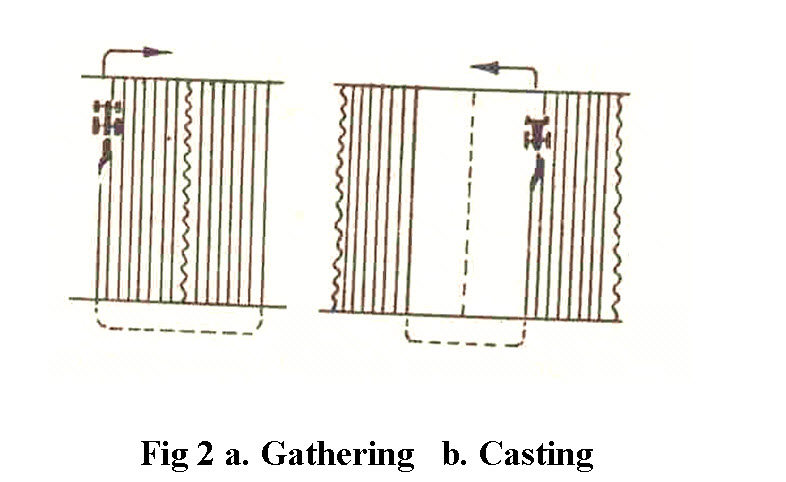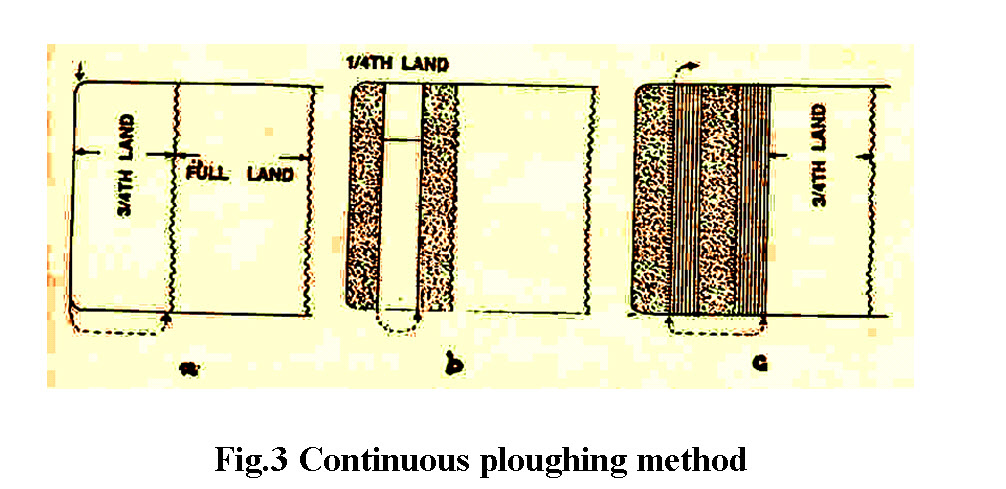Site pages
Current course
Participants
General
22 February - 28 February
1 March - 7 March
8 March - 14 March
15 March - 21 March
22 March - 28 March
29 March - 4 April
5 April - 11 April
12 April - 18 April
19 April - 25 April
26 April - 2 May
Lesson 7. Tillage: objectives, methods and terminology, introduction and classification of primary & secondary tillage equipment
Tillage: It is the mechanical manipulation of soil to provide favourable condition for crop production. It breaks the compact surface of earth to certain depth and loosens the soil mass so that roots of the crop penetrate and spread into the soil. These include ploughing, harrowing, mechanical destruction of weeds and breaking of soil crust.
Soil Crust: After sowing, if it rains the top layer of soil becomes so hard that seed is unable to germinate. This strong or hard top soil is called soil crust.
Objectives of Tillage:
1) To obtain deep seed bed, suitable for different type of crops. A granular structure is desirable to allow rapid infiltration and good retention of rainfall, to provide adequate air capacity and exchange within the soil
2) To control weeds or to remove unwanted crop plants (thinning)
3) To manage plant residues, thorough mixing of trash will add humus and fertility of soil, while retention of trash on surface reduces erosion
4) To minimize soil erosion by following such practices as contour tillage, listing and proper placement of trash
5) To establish specific surface configurations for planting, irrigating, drainage, harvesting operation etc.
6) To incorporate and mix fertilizers, pesticides or soil amendments into the soil
7) To accomplish segregation. This may involve moving the soil from one layer to another, removal of rocks and other foreign objects or root harvesting.
Classification of Tillage: Tillage can be classified into (a) primary tillage (b) secondary tillage:
(a) Primary Tillage: The operation performed to open up any cultivable land with a view to prepare a seedbed for growing crops, is termed as primary tillage. It is normally designed to reduce soil strength, cover plant materials and rearrange aggregates. The various equipments used for primary tillage are mould board plough, disc plough, heavy- duty disc harrow, chisel plough, rotavator etc.
(b) Secondary Tillage: Lighter and finer operations performed on the soil after primary tillage, are termed as secondary tillage. These operations are generally performed on surface soil. Very little inversion and shifting of soil takes place and consequently less power requirement per unit area. Implements are disc/other harrows, cultivators, sweeps, tillers etc.
Types of Tillage:
Apart from these major primary and secondary tillage operations we often do tillage in some other ways. These different types of tillage are discussed as follows:
(i) Minimum Tillage: Minimum soil manipulation necessary to meet tillage requirements for crop production. The major objectives are:
(a) To reduce mechanical energy and labour requirement
(b) To conserve moisture and reduce soil erosion.
(c) To perform only the operations necessary to optimize the soil conditions
(d) To minimize the number of trips over field
(e) Disadvantages: When surface plants residues are involved insects are increased and effective chemical weed control is essential
(ii) No- Tillage: In a single operation, sowing is done without tilling it at all. This is applied where moisture conservation is required. These are suitable in the areas where heavy rainfall is there.
(iii) Strip Tillage: Tillage system in which only isolated bands of soil are tilled.
(iv) Rotary Tillage: Tillage operations employing rotary action to cut, break and mix the soil, rotary tillers are used. These tillers have low or negative draft requirements, but total power requirements are high and pulverization may be excessive.
(v) Stubble-Mulch Tillage: It involves cutting the roots of weeds and other plants and leaving the crop residue on the surface or mixed into the top few centimetres of soil. This is done to reduce wind and water erosion and conserve water by reducing run-off. Mostly used in semi-arid and arid zones. Special blade type sub-surface tillers, v-shaped sweeps having cutting widths 0.6 to 2.4 m, straight blades, vertical disc plough, disc harrows, rotary hoes, chisel ploughs, cultivators.
(vi) Combined Tillage: Operations simultaneously utilizing two or more different types of tillage tools or implements to simplify, control or reduce the number of operations over a field are called combined tillage.
FIELD COVERAGE METHODS
Ploughing is the primary tillage operation, which is performed to cut, break and invert the soil partially or completely.
Normal Ploughing: It is the ploughing up to a depth of about 15 cm.
Contour Ploughing: It is the method of ploughing in which the soil is broken and turned along the contours.
Land Ploughing: While ploughing the land separates top layer of soil into furrow slices. The furrows are turned sideways and inverted to a varying degree, depending upon the type of plough being used. It is a primary tillage operation, which is performed to shatter soil uniformly with partial or complete soil inversion. There are a few important terms frequently used in connection with ploughing of land.


Furrow: It is an open trench formed by an implement in the soil during field operations.
Back Furrow: A raised ridge left at the center of a strip of land when plowing is started from center to side. When the ploughing is started in the middle of a field, furrow slice is collected across the field and while returning trip another furrow slice is lapped over the first furrow. This is the raised ridge which is named as back furrow
Dead Furrow: An open trench left in between two adjacent strips of land after finishing the plowing is called dead furrow or when two open furrows come together as when you finish working a piece of land that double furrow is called dead furrow.
Furrow Slice: It is the mass of soil cut, lifted and thrown to one side.
Furrow Wall: It is undisturbed soil surface by the side of furrow.
Crown: Top portion of turned furrow slice.
Headland: While plowing with a tractor a strip of unplowed land is left at each end of the field for tractor to turn. It is twice the width of the implement. At the end of each trip, the plough is lifted until the tractor and the plough have turned and are in position to start the return trip. The headland is about 6 meters for two or three bottom tractor plough and 1 metre more for each additional bottom.

Methods of ploughing
In order to provide furrows at all times on the right hand side of the plough two method of working are used a) Gathering b) Casting.

a) Gathering - Whenever a plough works round a strip of ploughed land, it is said to be gathering (Fig.2a).
b) Casting - Whenever a plough works round a strip of un-ploughed land, it is said to be casting (Fig.2b).
Ploughing of a field by casting or gathering alone is normally uneconomical. The following are a few important methods used in tractor ploughing.
i) Continuous ploughing method and
ii) Round and round ploughing
c) Continuous ploughing method
In normal conditions, the continuous ploughing method is considered very convenient and economical. This method is usually used when the tractor and plough never run idle for more than three quarter land width along the headland and never turn in a space narrower than a quarter land width. In this method, first the headland is marked and the first ridge is set up at three quarter of a land width from the side (Fig. 3a). The other ridges are set at full width over the field. The operator starts ploughing between the first ridge and the side land. The operator continues to turn left and cast in the three quarter land until a quarter land width of ploughing is complete on each side (Fig. 3b).

After this, the driver turns right and gathers round the land already ploughed on the first ridge. Gathering is continued till the un-ploughed strip in first three-quarter land has been ploughed and completed. This gathering reduces the first full land by a quarter (Fig. 3c). The remaining three quarter land can be treated in exactly the same manner as the original three quarter land. This process is repeated for all other lands in the field.
d) Round and round ploughing
In this method, the plough moves round and round a field. This system is adopted under conditions where ridges and furrows interfere with cultivation work. The field can be started various ways as follows:
1) Starting at the center: Small plot is marked in the middle of field and plowed first. After that plow works round this small plot and entire plot is completed. This is not very economical method.
2) Starting at outer ends: Tractor starts ploughing at one side of field and then moves on all sides of plot and comes gradually from sides to the center of field. Wide diagonals are left unplowed to avoid turning with the plough. There are no back furrows in this method. Conventional ploughing is usually done by this method.
3) 2700 turns from boundaries or centers.